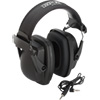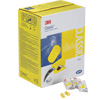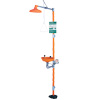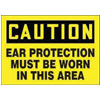
Noise Control & Hearing Protection Standards
Each year, thousands of workers suffer hearing loss due to high levels of noise in the workplace. The Occupational Safety and Health Administration (OSHA) aims to prevent hearing loss and protect workers with limits on noise exposure in the workplace. OSHA's permissible exposure limit (PEL) is 90 decibels (dBA) for all workers for an eight hour day.
"The OSHA standard uses a 5 dBA exchange rate. This means that when the noise level is increased by 5 dBA, the amount of time a person can be exposed to a certain noise level to receive the same dose is cut in half."
(OSHA Safety and Health Topics: Occupational Noise Exposure)
When to Use Hearing Protection
Generally speaking, if you need to shout in order to be heard three feet away, you are likely in a noise level that is 85 dBA or more, and hearing protection should be used. Typical work that requires hearing protection includes:
- Lawn mowers, leaf blowers, chain saws, or power tools
- Vacuums
- Aircraft/helicopters
- Night club staff
- Machine operators
| OSHA's Permissible Noise Exposures | |
|---|---|
| Duration per day, hours | Sound level dBA slow response |
| 8 | 90 |
| 6 | 92 |
| 4 | 95 |
| 3 | 97 |
| 2 | 100 |
| 1.5 | 102 |
| 1 | 105 |
| 0.5 | 110 |
| < .25 | 115 |
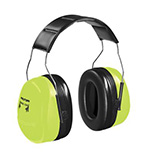
Types of Noise Control & Hearing Protection
The best way to protect against hearing loss is to block the noise with earplugs or earmuffs. OSHA requires that earplugs and earmuffs used in the workplace be tested and approved by the American National Standards Institute (ANSI).
Your ear protection should have an appropriate Noise Reduction Rating (NRR). NNR number represents level of noise protection possible if earplugs or earmuffs are worn alone.
The maximum NRR rating for earplugs is 33; for earmuffs it is 31.
Earplugs
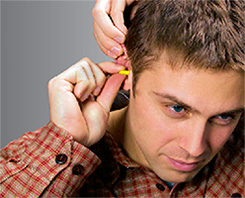
Earplugs are available as single-use/disposable and reusable.
Single-use earplugs are the most commonly used earplug in the workplace. They are affordable, sanitary, easy to use, and comfortable. General use, disposable earplugs are usually made of foam or wax. Dispensers are available for the workplace, making access easy and convenient.
Multiple-use earplugs save money and waste when workers are able to easily keep and reuse their own earplugs. They can be quite comfortable even for extended periods of time. Wearers of reusable earplugs must take care to clean and maintain them to get maximum useful life. Learn how to properly insert earplugs by downloading this earplug reference guide.
Earmuffs
Earmuffs block or reduce noise by creating a seal around the ear to prevent noise from reaching and damaging the inner ear. Noise-blocking earmuffs are widely used in certain industries like airlines, construction, and more. Also available are electronic earmuffs that can block harmful sound, but also offer two-way communication options and/or other specialize features like synching to music sources.
Shop Noise Control & Hearing Protection
NOTE: This information is a summary interpretation and was prepared as general reference material only. This summary is not authoritative as laws can be amended over time. For specific compliance requirements and updates, please refer to the actual code language and the statute or legal counsel.

